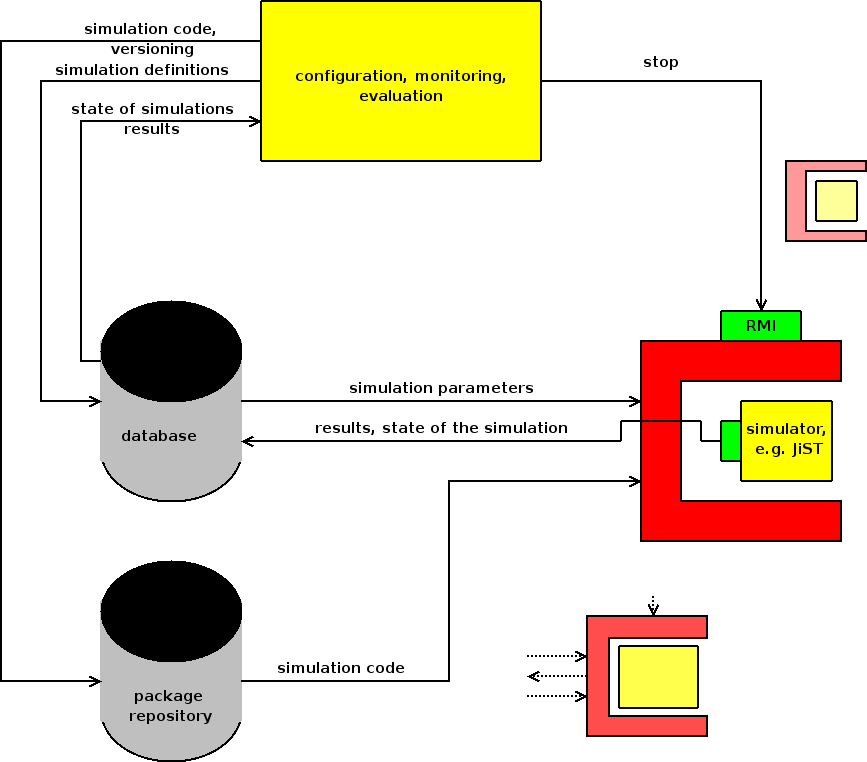DistSim
DistSim is provides tools to define parameters of simulations, exectute them on various hosts in a LAN and collect the results in a database. The parameters, results and references to the code used to perform the simulations are kept in a central MySQL data base, so that little manual organization of data is required and all results of past simulations are easily accessible for comparison. DistSim consists of the following components:

- The simulation wrapper is a small program running on the hosts intended to execute the simulations. It regularly checks for changes in the database, fetches new simulation jobs and executes them.
- The object-relational mapping library is a helper library to simplify storing the results of simulations. It can save (almost) arbitrary java objects into the database using a simple persistence mapping.
- The configuration library provides routines to define simulations, groups of simulations and studies. It can be used to programmatically create simulations.
- The configuration library is also the back end for the configuration client, a swing GUI for defining parameters of simulations.
HOWTO
The following guide shows how to set up a simple simulation and touches various aspects of DistSim. It is intended to be used as a starting point for more sophisticated setups.
Installation
In order to use DistSim you should set up a MySQL database. I won't go into great detail here, as there are other guides for that. You can execute the SQL script "tabellen" in the wrapper directory to create the necessary tables:
mysql> source wrapper/tabellen
Now you need to provide user accounts for various roles. One role is used for the configuration client, which needs write access to the configuration tables. Another one is used by the wrapper which needs write access to the results tables. You can reconfigure the database connection later, though. So if you just want to test the framework without caring much for security a simple
mysql> grant all on simulation to test_user identified by test_pwd
and
mysql> grant all on simulation_results to test_user identified by test_pwd
should be enough.
Also you need a Java JDK which supports at least the Java language version 5.0. The wrapper and OR-mapping should also work with version 1.4, but the client won't. Additionally for this tutorial you need Apache Ant, preferably version 1.6.5 or newer. To access the source code for DistSim you need a subversion client.
The installation procedure for DistSim itself is fairly short and easy. First you have to obtain the latest version of DistSim from the sarforge subversion repository. To do that you should check out https://sarforge.informatik.hu-berlin.de/svn/berlinroofnet/BerlinRoofNet/trunk/simulation/distsim:
$ svn co https://sarforge.informatik.hu-berlin.de/svn/berlinroofnet/BerlinRoofNet/trunk/simulation/distsim
In the distsim directory you'll find four subdirectories. client for the configuration client and library, or-mapper for the object-relational mapping library, and wrapper for the simulation wrapper. The fourth one, text, contains the actual thesis I wrote about DistSim. In order to make use of DistSim you should at least start one wrapper. First you will want to compile the wrapper with
$ ant compile
in the wrapper directory. Then you should edit the wrapper.properties and host1.properties files in the wrapper directory. You need to provide database parameters for the results and configuration databases as well as various properties of the host itself. The example configuration looks like this:
host1.properties:
host.id 1 host.description gurkenhannes host.architecture x86_linux host.name brn-suse093-1
wrapper.properties:
definitions.host localhost defintions.database simulation definitions.username alve definitions.password hannes results.host localhost results.database simulation_results results.username alve results.password hannes
When these properties all contain correct values you can start the wrapper by piping the properties into its standard input. For example like this:
$ cat host1.properties wrapper.properties | ant run
For this trick you need at least ant 1.6.5, otherwise the input won't be passed on. Now the wrapper is running and waiting for simulation jobs. To define these jobs you'll need the configuration client. The client needs to know the interface RemoteSimulation so that it can connect to the wrapper's RMI interface. This interface is part of the wrapper. in order to let the client know about RemoteSimulation, you need to build a .jar library of the wrapper and copy it to client/lib. In the wrapper directory this involves the following commands:
$ ant jar $ cp wrapper.jar ../client/lib
Now you can start the client with
$ ant run
in the client directory.
defining a package
In order to actually simulate anything a package with the code to be executed needs to be available. I'm using [[1]] with a simple simulation as example. The Code for the example simulation can be found here. The example has to be copied to the directory src/jist/minisim in the JiST distribution. Then the whole jist distribution needs to be packed as a .zip file. The resulting package should then be uploaded to a place where it is accessible for the hosts executing the simulations. In the long run an ftp-Server might be a good solution. For now we can just leave it somewhere on the local disc and start the wrapper on the same computer. Let's define the package to be at /home/user/distsim-test.zip.